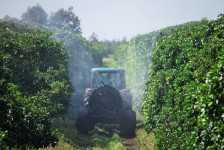Rotate Insecticides For Long-Term Efficacy

What’s the economic threshold for Asian citrus psyllid (ACP)? For many citrus producers, just one. Perhaps that’s not the technical answer. But given that tiny winged creature’s power to wreak destruction on citrus groves, that’s the psychological impact on a grower making a decision on whether to spray. These days the question isn’t whether to spray; it’s what to spray when. “Timing is complicated and it’s area specific,” says Lukasz Stelinski, UF/IFAS entomologist.
One high priority is controlling insects at flush — not only for controlling ACP, but also populations of some secondary pests, particularly citrus leafminer, the essential pest to control to limit the spread of Florida’s second-most damaging disease, canker. “Timing an insecticide spray prior to new leaf flush is extremely important,” Stelinski says. “The psyllid uses new leaf flush exclusively to lay eggs for the second generation.”
Growers must target treatment to effectively manage pests while rotating every mode of action available to hold on to the efficacy of all treatment options. It’s the only way to stay well-armed in the battle against not only HLB, but also canker and the whole host of insects and diseases bent on causing fruit drop and decreasing yields in Florida’s citrus crop. “You just can’t control psyllids today by spraying only pyrethroids and organophosphates,” says Scott Houk, Dow AgroSciences sales representative.
Already, University of Florida entomologist Dr. Phil Stansly says, growers are relying too heavily on broad-spectrum chemistries. “Right now the more inexpensive products, which would include the pyrethroids, the organophosphates, and now even imidacloprid, tend to be used more often and those I think are the ones that are most endangered of being lost,” he says.
At this point, Stansly urges growers to use pyrethroids and organophosphates during the dormant season and make use of selective chemistries during the growing season. “As a rule, we think of the dormant season as a time for broad-spectrum insecticides and the whole growing season we prefer selective insecticides to be used then,” Stansly says. “We think that there’s less possibility of secondary pest outbreaks if we utilize selective materials.”
The goal is to control pests effectively while ensuring continued efficacy for all available chemistries, growers and researchers agree. “If we don’t use these pesticides efficiently and rotate effectively,” Stelinkski says, “resistance is on the horizon.”









